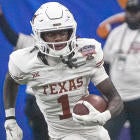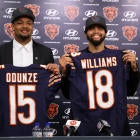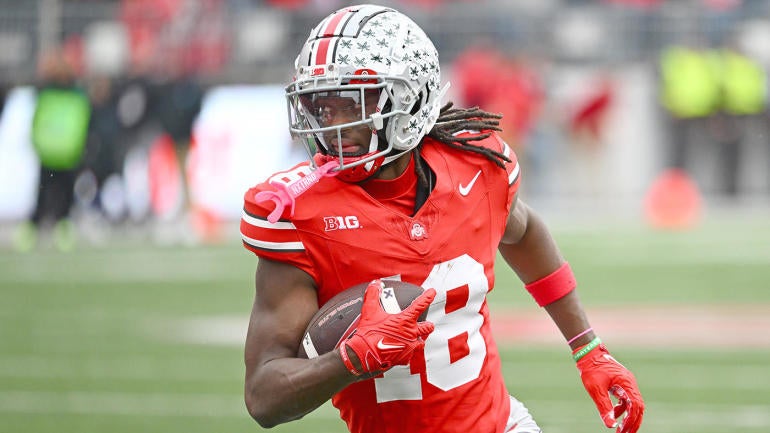
Quarterbacks are the talk of the upcoming 2024 NFL Draft, and rightfully so, considering five different signal-callers could easily come off the board in the first round. But wide receivers may be just as plentiful, with three pass catchers in the top 10 of CBS Sports' 2024 prospect rankings, and seven in the top 32. By those metrics, 20% of Day 1 picks could come at receiver.
Two schools, in particular, have a heavy hand in the rich class of pass catchers: LSU and Ohio State. The latter produced Marvin Harrison Jr., son of Indianapolis Colts Hall of Famer Marvin Harrison and CBS Sports' top-ranked overall prospect, widely expected to be a top-five pick. LSU, meanwhile, has not one but two different wideouts projected to be first-round picks in Malik Nabers and Brian Thomas Jr.
Obviously past prospects can't fully predict how individual players with individual landing spots will develop at the pro level. Take Alabama, for example: The Crimson Tide appeared to have a historical edge over Ohio State in terms of quarterback prospects ahead of 2023, only for C.J. Stroud to outshine Bryce Young as a rookie. Or Oregon, which had a prominent history of quarterback busts, only for Justin Herbert to burst onto the NFL scene.
But if you're wondering which of this year's top wideouts -- Harrison, Nabers, Thomas -- hails from a more proven line of recent college-turned-NFL pass catchers, we've surveyed the last 30 years of LSU and Ohio State receivers to enter the league. More specifically, any Tigers or Buckeyes product to be picked in the first three rounds of the draft, since the hit rate on post-Round 3 receiver picks is particularly gloomy.
Here's a look:
LSU
Note: Statistics are for a player's entire NFL career
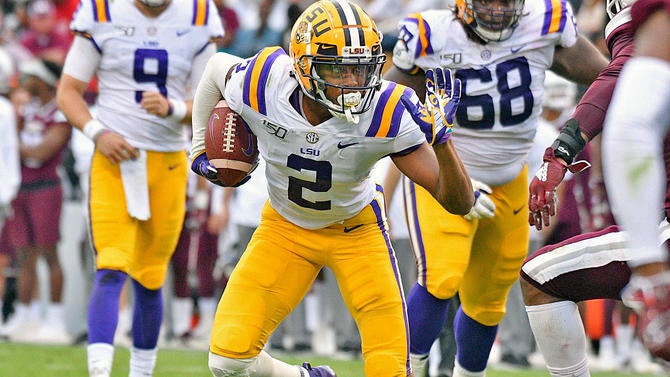
| Year | WR | Drafted | Team | Years | Yards | TDs | Pro Bowls |
|---|---|---|---|---|---|---|---|
| 2021 | Ja'Marr Chase | 1 (5) | Bengals | 3+ | 3,717 | 29 | 3 |
| 2021 | Terrace Marshall Jr. | 2 (59) | Panthers | 3+ | 767 | 1 | 0 |
| 2020 | Justin Jefferson | 1 (22) | Vikings | 4+ | 5,899 | 30 | 3 |
| 2018 | D.J. Chark | 2 (61) | Jaguars | 6+ | 3,069 | 23 | 1 |
| 2014 | Odell Beckham Jr. | 1 (12) | Giants | 10+ | 7,932 | 59 | 3 |
| 2014 | Jarvis Landry | 2 (63) | Dolphins | 9 | 7,870 | 38 | 5 |
| 2012 | Rueben Randle | 2 (63) | Giants | 4 | 2,644 | 20 | 0 |
| 2010 | Brandon LaFell | 3 (78) | Panthers | 9 | 5,398 | 11 | 0 |
| 2008 | Early Doucet | 3 (81) | Cardinals | 5 | 1,491 | 7 | 0 |
| 2007 | Dwayne Bowe | 1 (23) | Chiefs | 9 | 7,208 | 44 | 1 |
| 2007 | Craig Davis | 1 (30) | Chargers | 4 | 558 | 2 | 0 |
| 2004 | Michael Clayton | 1 (15) | Buccaneers | 8 | 2,955 | 10 | 0 |
| 2004 | Devery Henderson | 2 (50) | Saints | 9 | 4,377 | 20 | 0 |
| 2002 | Josh Reed | 2 (36) | Bills | 8 | 3,575 | 10 | 0 |
| 1996 | Eddie Kennison | 1 (18) | Rams | 13 | 8,345 | 42 | 0 |
The final tally for LSU:
- Total picks: 15
- Active in NFL: 5 (2 unsigned)
- Total Pro Bowlers: 6
- Total Pro Bowl selections: 16
- Total yards: 65,805
- Total TDs: 346
Ohio State
Note: Statistics are for a player's entire NFL career
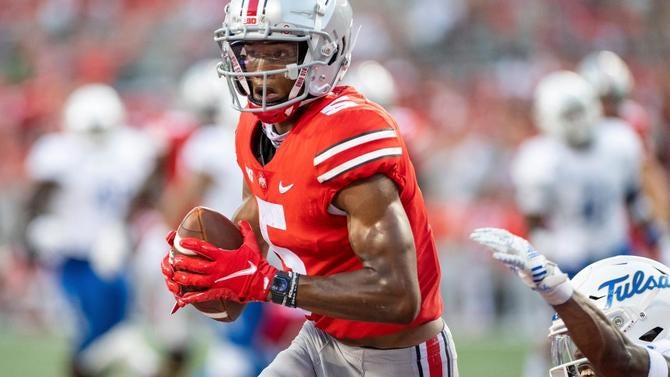
| Year | WR | Drafted | Team | Years | Yards | TDs | Pro Bowls |
|---|---|---|---|---|---|---|---|
| 2023 | Jaxon Smith-Njigba | 1 (20) | Seahawks | 1+ | 628 | 4 | 0 |
| 2022 | Garrett Wilson | 1 (10) | Jets | 2+ | 2,145 | 7 | 0 |
| 2022 | Chris Olave | 1 (11) | Saints | 2+ | 2,165 | 9 | 0 |
| 2019 | Parris Campbell | 2 (59) | Colts | 5+ | 1,087 | 5 | 0 |
| 2019 | Terry McLaurin | 3 (76) | Commanders | 5+ | 5,283 | 25 | 1 |
| 2017 | Curtis Samuel | 2 (40) | Panthers | 7+ | 3,383 | 22 | 0 |
| 2016 | Michael Thomas | 2 (47) | Saints | 8+ | 6,569 | 36 | 3 |
| 2016 | Braxton Miller | 3 (85) | Texans | 2 | 261 | 2 | 0 |
| 2015 | Devin Smith | 2 (37) | Jets | 4 | 248 | 2 | 0 |
| 2012 | DeVier Posey | 3 (68) | Texans | 3 | 272 | 0 | 0 |
| 2009 | Brian Robiskie | 2 (36) | Browns | 5 | 485 | 4 | 0 |
| 2007 | Ted Ginn Jr. | 1 (9) | Dolphins | 14 | 5,742 | 33 | 0 |
| 2007 | Anthony Gonzalez | 1 (32) | Colts | 5 | 1,307 | 7 | 0 |
| 2006 | Santonio Holmes | 1 (25) | Steelers | 9 | 6,030 | 36 | 0 |
| 2004 | Michael Jenkins | 1 (29) | Falcons | 9 | 4,427 | 25 | 0 |
| 1999 | David Boston | 1 (8) | Cardinals | 7 | 4,699 | 25 | 1 |
| 1996 | Terry Glenn | 1 (7) | Patriots | 12 | 8,828 | 44 | 1 |
| 1995 | Joey Galloway | 1 (8) | Seahawks | 16 | 10,950 | 77 | 0 |
| 1995 | Chris Sanders | 3 (67) | Texans | 8 | 3,285 | 17 | 0 |
The final tally for Ohio State:
- Total picks: 19
- Active in NFL: 7 (1 unsigned)
- Total Pro Bowlers: 4
- Total Pro Bowl selections: 6
- Total yards: 67,794
- Total TDs: 380
Takeaways
So how do the two schools stack up over the last three decades?
Let's start with quantity: Since 1994, Ohio State has produced slightly more NFL wideouts through the top of the draft, with 19 picks to LSU's 15. This helps explain why the Buckeyes are superior in the combined yardage and touchdown departments, which would be inflated even more if, say, special-teams scores by career return man Ted Ginn Jr. were included. All in all, though, you can see how close this really is; both programs have had a remarkable run of turning college standouts to effective pros, with each school seeing five different players top 5,000 career receiving yards on the NFL stage during this span.
The disparity in Pro Bowl nods is also a bit misleading; those marks could easily be closer, reinforcing the closeness of this comparison, when considering the ageless Galloway somehow never managed a single all-star appearance. But there are some factors that do suggest a lean in LSU's favor: Galloway and Glenn, for example, account for almost 20,000 of Ohio State's combined 67,000+ yards -- or 29% -- while the Tigers have been steadier across the board; just two LSU wideouts have fewer than 1,000 career yards (and one just started his NFL career in 2023), while OSU has seen five with that distinction.
It's hard to fully unshackle recency bias when it comes to LSU's current stars; Justin Jefferson and Ja'Marr Chase have been the class of the position at such a young age, setting the standard for contemporary playmakers. Certainly Ohio State has been nearly, if not just as reliable of late, with four of its last six Round 1-3 picks being Pro Bowl-caliber weapons Garrett Wilson, Chris Olave, Terry McLaurin and Michael Thomas. In the end, however, the numbers would suggest that LSU is giving you slightly more bang for your buck, producing both durable and game-breaking stars with slightly fewer early-round selections.
Just don't go counting out the Buckeyes, especially with Harrison about to follow in his father's footsteps.















